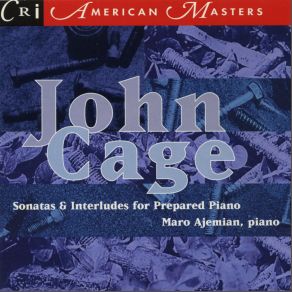John Cage: Sonatas and Interludes for Prepared Piano
Download links and information about John Cage: Sonatas and Interludes for Prepared Piano by Maro Ajemian. This album was released in 1983 and it belongs to genres. It contains 19 tracks with total duration of 01:06:49 minutes.

|
|
|---|---|
| Artist: | Maro Ajemian |
| Release date: | 1983 |
| Genre: | |
| Tracks: | 19 |
| Duration: | 01:06:49 |
| Buy it NOW at: | |
| Buy on iTunes $9.99 | |
| Buy on Amazon $8.99 | |
Tracks
[Edit]| No. | Title | Length |
|---|---|---|
| 1. | Sonatas and Interludes for Prepared Piano: Sonata I | 3:06 |
| 2. | Sonatas and Interludes for Prepared Piano: Sonata II | 2:29 |
| 3. | Sonatas and Interludes for Prepared Piano: Sonata III | 2:46 |
| 4. | Sonatas and Interludes for Prepared Piano: Sonata IV | 3:10 |
| 5. | Sonatas and Interludes for Prepared Piano: First Interlude | 3:47 |
| 6. | Sonatas and Interludes for Prepared Piano: Sonata V | 1:31 |
| 7. | Sonatas and Interludes for Prepared Piano: Sonata VI | 2:24 |
| 8. | Sonatas and Interludes for Prepared Piano: Sonata VII | 2:36 |
| 9. | Sonatas and Interludes for Prepared Piano: Sonata VIII | 2:58 |
| 10. | Sonatas and Interludes for Prepared Piano: Second Interlude | 4:19 |
| 11. | Sonatas and Interludes for Prepared Piano: Third Interlude | 3:07 |
| 12. | Sonatas and Interludes for Prepared Piano: Sonata IX | 4:06 |
| 13. | Sonatas and Interludes for Prepared Piano: Sonata X | 3:36 |
| 14. | Sonatas and Interludes for Prepared Piano: Sonata XI | 3:29 |
| 15. | Sonatas and Interludes for Prepared Piano: Sonata XII | 4:17 |
| 16. | Sonatas and Interludes for Prepared Piano: Fourth Interlude | 2:47 |
| 17. | Sonatas and Interludes for Prepared Piano: Sonata XIII | 4:07 |
| 18. | Sonatas and Interludes for Prepared Piano: Sonatas XIV and XV | 7:11 |
| 19. | Sonatas and Interludes for Prepared Piano: Sonata XVI | 5:03 |
Details
[Edit]French pianist Gerard Fremy's interpretation of Cage's classic Sonatas and Interludes for Prepared Piano provides a new insight into this cycle of works exploring the prepared piano. Performances are fresh and lively with plenty of energy. Fremy had, at the time of the release of this recording, performed this cycle nearly 30 times — and frequently with Cage himself in the audience. Cage's innovation of the prepared piano stems from his desire to expand the usage of the instrument, transforming it into both a melodic instrument and percussion rack. He did this by instructing the performer to use various items (often screws) to modify the strings being struck by the piano hammers. The result is a single instrument that takes on the sound of a multi-instrumental session. Tones range from hollow gong sounds to chimes to cymbal clangs or dead drum sounds — not to mention the classic piano sound. Compositions show Cage experimenting with the possibilities of this type of technique. The recording quality is only fair and the CD packaging is poor. ~ Mark W. B. Allender, Rovi